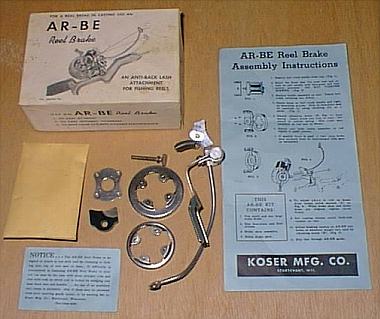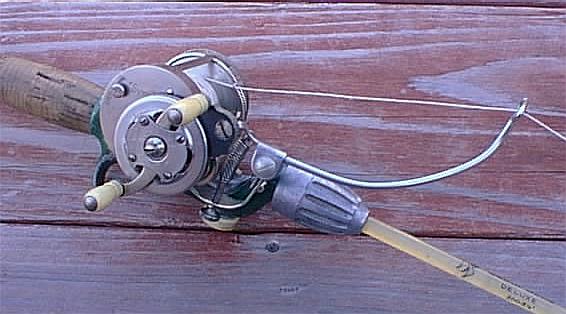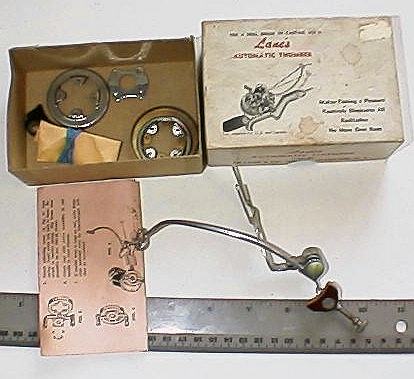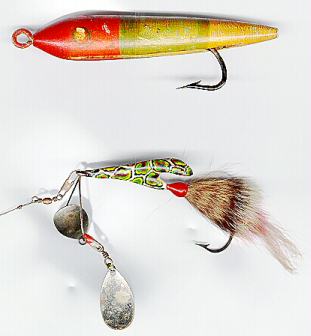





Ah, the good old days when an angler knew he had become a true fisherman by successfully unsnarling his first backlash in the dark! For many today, the experience of a backlashed reel will never be known since advanced technology in casting reel design, not to mention the use of spin casters has pretty much eliminated this once-common problem.
Back in the days of the early casters, however, the backlash could put an end to an evening of fishing, particularly for the younger novice fisherman whose casting techniques were not as polished as that of a more experienced angler. Still, as a young lad, I remember even Dad occasionally mumbling to himself certain words which, for a youngster, I probably should not have overheard while unsnarling his own backlashed reel!
To help combat this problem, one enterprising fellow named Ray Koser of Sturdevant, Wisconsin, a tool and dye maker by trade, designed a clever gadget he called the "AR-BE Reel Brake". After World War II, Ray began working on the problem of coming up with a way to prevent backlashing and designed a tension device that worked in combination with the reel to allow casting without thumbing, yet avoid backlashing.
The AR-BE Reel Brake kit consisted of a frame with a adjustable tension arm, 2 different size brake shoes, adjusting screw, a face plate with 4 screws, and a large and small size brake drum. The size of the reel determined what size brake drum and shoe was needed.
The brake drum is attached to the reel handle using the face plate. Once attached, the handle is put back on the reel. The frame is then slide over and around the reel seat and the front 'tongue' slide under the rod's reel retainer to hold it in place.
Next, a screw on the tension arm assembly is used to adjust the brake shoe right or left to align properly with the brake drum. A adjustable screw is then threaded into a tension spring and used to adjust the tension between the brake shoe and drum. Finally, the line is threaded through the line guide arm.

This past summer, I found this device in a box of tackle I bought. As I lived near Sturdevant, I did some research to see if the company was still in business but found it was not. A phone directory search, however, revealed a couple of Kosers living in the town. One turned out to be Ray's brother, Ervin who gave me some of the background on the company and also told me Ray was currently living in Florida. I was able to contact him and he provided the following information for this article.
The history of the Koser Manufacturing Company and the AR-BE Reel Brake is a bit brief. Ray began making and marketing the device in 1947 in a small shop in Sturdevant, along with his brother, Al and their two wives, Bernice and Elsie. The name AR-BE came from using the first letter of each of their names (A)l, (R)ay, (B)ernice, and (E)lsie.
The reel brake was the only item the company made. It was advertised in some of the sporting magazines of the time (Field & Stream to name one) and was sold through tackle shops for under $10. Brother Al took the device to the local sports shows' for demonstrations. Although markings on the box indicate 'patent pending', Ray said that a patent was never applied for.

Lane's Automatic Thumber
About one year after production began, manufacturing ceased and the entire inventory was sold to Lane & Company, a sporting goods manufacturer, in Wyoming, New York. As far as is known, Lane sold the device but never manufactured any more.
Related Articles / Pages:
AR-BE Reel on My Bait Shop: The updated version of this page. Updated with new information, pictures and links from our parent website, My Bait Shop.


These two unknown lures come to us from NFLCC member Randy Whiteman. Randy said that the top lure is spring loaded. Randy noted that the owner said they were his wife's grandfather's. The owner's wife is in her 60's.

If you have any further information on any of the items displayed on this page which you'd like to share, please send your comments to me and I'll update the page accordingly. Contributions of interesting items and/or unknowns are encouraged. Lures pictured in Lure Lore are not for sale.

Comments? EMAIL ME!